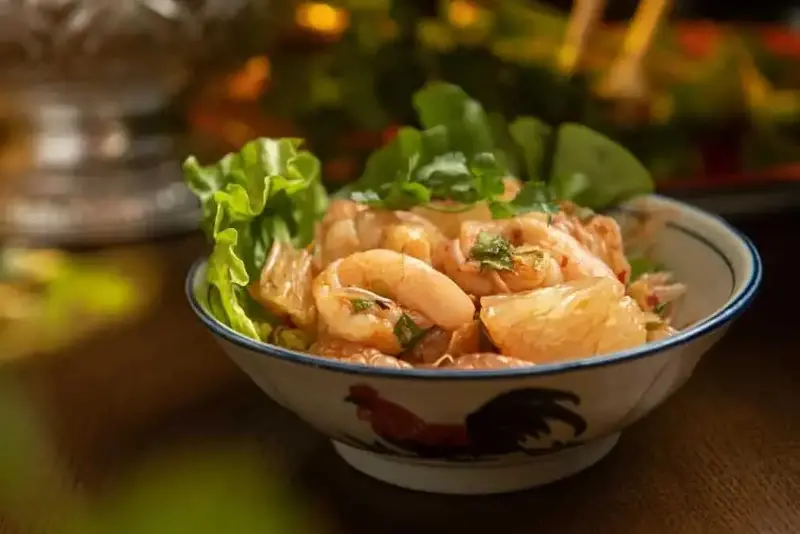
Pomelo carries a longer story than most people realise. It travelled across ancient trade routes, shifting hands through coastal markets, river ports, and old farming communities that treated it as a seasonal marker. In many parts of India, especially the East, the fruit slowly moved from a festive symbol to an everyday winter ingredient. People usually think of it as something to eat fresh, yet it has a quiet versatility that slips under the radar. Its thick rind, firm segments, and steady flavour make it suitable for slow cooking, gentle mashing, or even warm preparations that highlight its natural depth.
Some households use it in simple vegetable dishes, while others turn it into soft, comforting mixes that resemble traditional mash-style bhorta plates. The fruit responds well to heat, holds its shape, and absorbs spices in a balanced way. Many communities also use the inner membranes and peel in small culinary habits that show how resourceful regional food culture can be. Pomelo’s character allows it to travel between raw salads, side dishes, and many other preparations without losing its identity, which is why it adapts to so many winter meals even when people do not expect it to. Explore five unique dishes from the regions that will help you discover new ways to eat and serve pomelo.
Read More: Why You Must Eat Pomelo? Know This Fruit's Health Benefits
5 Mashed Pomelo Salad Preps From Bengal And East India

(Image Credits: Freepik)
Batabi Lebu Chingri Style Makha
Batabi Lebu Chingri Style Makha follows the structure of a Bengal mash technique, where ingredients are combined to create an even mixture without heat-heavy cooking. The prawn component is cooked separately with a simple spice base that follows the structure of light Bengali seafood preparations. Once it turns firm and releases its natural flavour, it is cooled slightly and broken into small flakes. The pomelo pulp is cleaned, pressed, softened by hand. The warm prawn mixture is folded in slowly so the citrus absorbs the spice evenly. A final round of mixing binds everything into a cohesive makha where the seafood flavour blends gently with the fruit.

(Image Credits: Freepik)
The idea mirrors the balance used in seafood-inspired mixes, where citrus provides the main profile. Pomelo fits this format because its fibres remain firm and do not break down into liquid, which helps maintain a clear mash structure. The flavour remains mild and controlled, which allows the citrus character to stay noticeable without overpowering the preparation. This dish is usually preferred in winter when the fruit is naturally firm and easy to buy.
Batabi Lebu Bhorta
A light tempering is prepared using a basic spice mix commonly used for Bengal bhorta dishes. This is added hot to the mashed pomelo so the warmth opens the citrus fibres and the spice spreads through the mixture. The pulp is kneaded until it turns smooth but still structured. The spice coating creates a balanced, warm flavour that fits the traditional bhorta format. The process follows the established Bhorta technique used across Bengal for vegetables and citrus-based ingredients.

(Image Credits: Freepik)
The flavour profile focuses on gentle acidity and soft bitterness, which creates a balanced outcome suitable for rice-centred meals. The preparation keeps heat handling minimal, which preserves the fruit’s natural structure. Winter pomelo works best because the pulp stays firm and forms a steady mash without becoming loose. It differs from other pomelo mash preparations because the outcome depends entirely on texture management and controlled mixing of the fruit as the sole ingredient with spices.
Batabi Lebu Khosha Bhaja
The peel is softened first, then cooked on high heat. A dry masala is sprinkled during the final stage so the spice attaches to the exterior while the heat locks it in. The peel absorbs only a mild amount of flavour because of its firm texture, creating a crisp, lightly seasoned preparation that relies on the natural bitterness of the rind.
This method transforms the peel from a discarded part into a functional winter side dish. The flavour profile centres on mild bitterness supported by a light citrus note that remains after cooking. The dish pairs well with rice because the firm pieces contrast with softer components on the plate. This makes it a distinctive addition to winter meals, offering a texture not present in other pomelo preparations and demonstrating the versatility of the fruit.
Robab Tenga Pitika
A warm Northeastern-style spice mixture is prepared separately. This mix is folded gently into the lightly crushed pomelo pulp so the flavours disperse without flattening the fruit. The pitika is shaped loosely to preserve its rustic character. The spice remains subtle, keeping the natural citrus prominent, which is typical of regional pitika dishes. The Pitika technique from the Northeast focuses on preserving natural flavours through minimal handling and controlled mixing.

(Image Credits: Freepik)
The flavour remains clean, mild, and lightly acidic, which aligns with the region’s preference for gentle, natural profiles. Its uniqueness lies in the way Northeastern food culture treats citrus as a core component of savoury dishes rather than a garnish. The dish preserves the identity of the fruit while making it suitable for daily consumption. Unlike Bengal-style Bhorta, Pitika avoids heavy seasoning or heat, resulting in a clearer flavour expression.
Robab Tenga Salad
Robab Tenga Salad is made by separating the pomelo into uniform segments and combining them lightly to maintain shape. The preparation avoids processes that break down texture, which ensures each piece remains distinct. The flavour profile centres on gentle acidity, steady sweetness, and a light aroma that suits winter meals. Pomelo performs well in salads because it holds its structure without releasing excess moisture.
The dish aligns with Northeastern preferences for fresh, minimal interventions where the fruit remains the primary source of flavour. Its uniqueness comes from its straightforward approach, which contrasts sharply with mash-based preparations. This method reflects a broader eating pattern in the region where seasonal produce is served in simple formats that respect the ingredient’s natural character.
